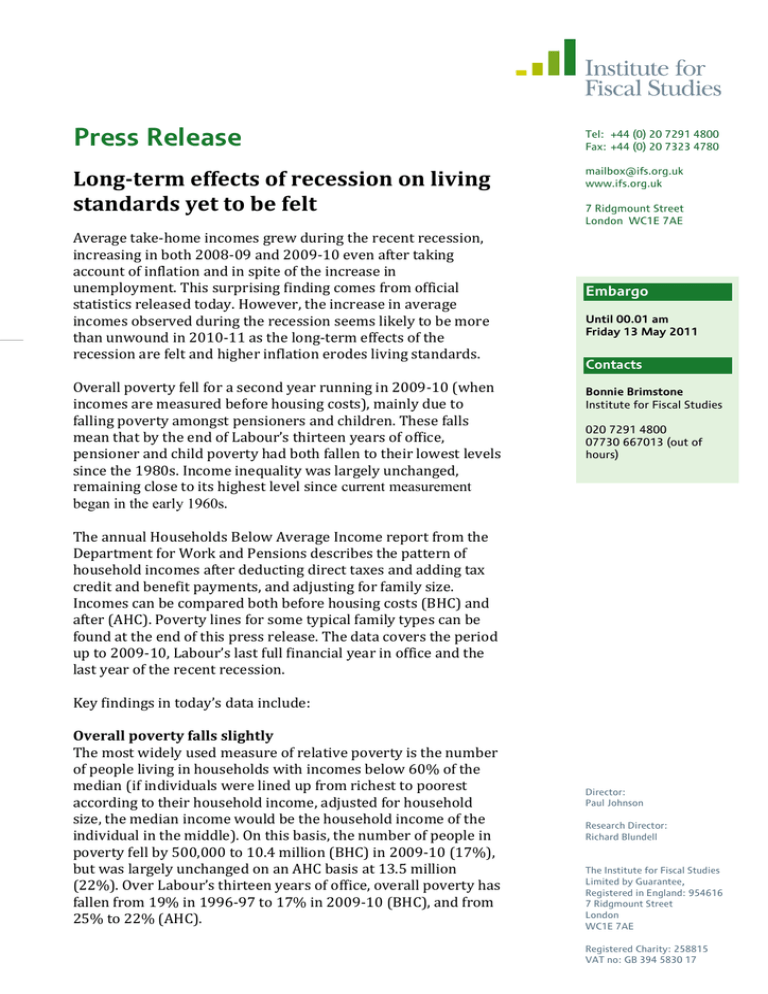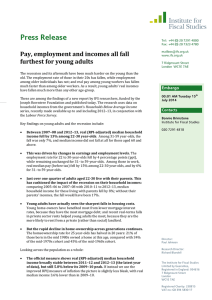Press Release Long-term effects of recession on living
advertisement

Press Release Tel: +44 (0) 20 7291 4800 Fax: +44 (0) 20 7323 4780 Long-term effects of recession on living standards yet to be felt mailbox@ifs.org.uk www.ifs.org.uk Average take-home incomes grew during the recent recession, increasing in both 2008-09 and 2009-10 even after taking account of inflation and in spite of the increase in unemployment. This surprising finding comes from official statistics released today. However, the increase in average incomes observed during the recession seems likely to be more than unwound in 2010-11 as the long-term effects of the recession are felt and higher inflation erodes living standards. Overall poverty fell for a second year running in 2009-10 (when incomes are measured before housing costs), mainly due to falling poverty amongst pensioners and children. These falls mean that by the end of Labour’s thirteen years of office, pensioner and child poverty had both fallen to their lowest levels since the 1980s. Income inequality was largely unchanged, remaining close to its highest level since current measurement began in the early 1960s. 7 Ridgmount Street London WC1E 7AE Embargo Until 00.01 am Friday 13 May 2011 Contacts Bonnie Brimstone Institute for Fiscal Studies 020 7291 4800 07730 667013 (out of hours) The annual Households Below Average Income report from the Department for Work and Pensions describes the pattern of household incomes after deducting direct taxes and adding tax credit and benefit payments, and adjusting for family size. Incomes can be compared both before housing costs (BHC) and after (AHC). Poverty lines for some typical family types can be found at the end of this press release. The data covers the period up to 2009-10, Labour’s last full financial year in office and the last year of the recent recession. Key findings in today’s data include: Overall poverty falls slightly The most widely used measure of relative poverty is the number of people living in households with incomes below 60% of the median (if individuals were lined up from richest to poorest according to their household income, adjusted for household size, the median income would be the household income of the individual in the middle). On this basis, the number of people in poverty fell by 500,000 to 10.4 million (BHC) in 2009-10 (17%), but was largely unchanged on an AHC basis at 13.5 million (22%). Over Labour’s thirteen years of office, overall poverty has fallen from 19% in 1996-97 to 17% in 2009-10 (BHC), and from 25% to 22% (AHC). Director: Paul Johnson Research Director: Richard Blundell The Institute for Fiscal Studies Limited by Guarantee, Registered in England: 954616 7 Ridgmount Street London WC1E 7AE Registered Charity: 258815 VAT no: GB 394 5830 17 Lowest levels of child and pensioner poverty since 1980s Pensioner poverty fell by 200,000 measuring incomes BHC, but was largely unchanged on an AHC basis. Standing at 18% (BHC) and 16% (AHC) in 2009-10, pensioner poverty stood at its lowest level since 1984 on both measures by the end of Labour’s period in office. The fall in pensioner poverty in 2009-10 is not unexpected; pensioners are largely unaffected by the rising unemployment experienced by working-age adults and the majority of their income comes from state pensions and benefits which increased by well-above inflation in that year. Child poverty fell by 200,000 measuring incomes BHC and by 100,000 measuring incomes AHC. This fall left child poverty at 20% (BHC) in 2009-10, its lowest level since 1985 and significantly below the level just before Labour came to power, standing at 27% in 1996-97. Measuring incomes AHC, child poverty was 29% in 2009-10, still slightly higher than the recent low point in 2004-05 (28%), but lower than just before Labour came to power in 1996-97 (34%). The fall in child poverty in 2009-10 is likely to reflect the aboveinflation increases in benefits and tax credits that year. These increases partly reflect policy decisions by the last Labour government but were mainly driven by falling inflation. . However, child poverty would still need to fall by a further 900,000 in just one year to meet the previous government’s 2010 target of halving child poverty. IFS research suggests that this target will be missed by about 900,000 children, so that child poverty will have fallen by around a quarter since 1998-99, rather than by a half, as the previous government hoped to achieve. Poverty amongst working-age adults without children continues to rise and reaches new high Poverty amongst working-age adults without dependent children rose in 2009–10 measuring incomes AHC, possibly reflecting rising unemployment and partly offsetting the falls in pensioner and child poverty. It now stands at its highest level since at least the start of our consistent series in 1961; with the fraction in poverty at 15% measuring incomes BHC or 20% using incomes measured AHC in the latest year of data. Average incomes rose during recession, but likely to fall back again afterwards Average take-home incomes grew in real-terms in 2009–10. Mean incomes grew by 1.6%, whilst median incomes grew by around 1%. Following on from growth in average incomes in 2008-09, this means that average incomes rose in both years of The Institute for Fiscal Studies Limited by Guarantee, Registered in England: 954616 7 Ridgmount Street London WC1E 7AE the recent recession in spite of the falls in real GDP per head and increased unemployment. This growth actually continues the pattern of sluggish growth observed up to 2007-08. A large part of this increase in average incomes seems likely to be a temporary effect resulting from the uprating rules for benefits and tax credits. Falling inflation meant that most benefits and tax credit rates went up by more than inflation over this period, which was just 0.5% in 2009-10 (as measured by the RPI). This effect seems likely to be more than unwound in 201011 as inflation rose. Most benefits and tax credits were uprated by under 2% in 2010-11, whilst inflation averaged around 5% during 2010-11. The outlook for average incomes in 2010-11 is thus not nearly as positive, particularly as earnings fell by 3.8% in real-terms over the first eleven months of 2010-11. Recent IFS research forecasts a fall of 2.2% in median income between 2008-09 and 2010-11. As we observe a 1% rise in median incomes in 2009-10, median incomes would need to fall by around 3% in 2010-11 for this forecast to be correct. The trends in earnings and benefits suggest that such a fall is entirely possible. And were such a fall to be found in next year’s data, it would represent the largest fall in median incomes since 1981, leaving median income close to its level in 2004-05. The increases in living standards observed during the recession are therefore likely to be just temporary. Income inequality remains at a record high. The Gini Coefficient – a commonly used measure of income inequality – was unchanged at 0.36 in 2009-10 (BHC). It thus remains at its highest level seen during the IFS’s consistent time series going back to 1961 (just as it was last year). “The figures released today tell a story of pain delayed, but not pain avoided,” says Wenchao Jin, a Research Economist at the IFS. “Average living standards rose over the recent recession, likely to be driven by large increases in benefits and tax credit rates. However, this type of growth cannot be sustained in the long term, and the outlook for incomes in 2010-11 is considerably bleaker, with the long-terms effects of the recession on living standards delayed rather than avoided.” “Further falls in the rate of relative poverty amongst children and pensioners mean that poverty for these groups is at its lowest level since the 1980s. Indeed, for pensioners, relative poverty has been lower in only two or three years out of the last fifty,.” says David Phillips, a Senior Research Economist at the IFS. “Looking ahead, however, it seems almost certain that the last government’s target to reduce child poverty by half between The Institute for Fiscal Studies Limited by Guarantee, Registered in England: 954616 7 Ridgmount Street London WC1E 7AE 1998-99 and 2010-11 will be missed by a considerable distance. Research by IFS economists further suggests that child poverty will increase by around 300,000 by 2013-14, driven largely by cuts to the generosity of benefits and tax credits by the coalition government.” ENDS Notes to Editors: 1. The full Households Below Average Income publication can be found on the Department for Work and Pensions website at (http://research.dwp.gov.uk/asd/hbai/hbai2010/index.php?page=contents) 2. IFS forecasts for child poverty and median incomes can be found at the following link (http://www.ifs.org.uk/publications/5540). 3. Further analysis of the data underlying the official statistics will be available in Poverty and Inequality in the UK: 2011 by Wenchao Jin, Robert Joyce, David Phillips and Luke Sibieta. This report will be launched at IFS on 13 May 2010. The briefing will start at 9:30am and is expected to conclude by 11:00am. If you would like to attend, please contact Bonnie Brimstone (020 7291 4800 or bonnie_b@ifs.org.uk). 4. The official HBAI document reports numbers in poverty to the nearest 100,000, but reports changes in poverty based on the unpublished unrounded numbers. Where no official estimate exists of the change in poverty between two years, this note reports the change in the rounded numbers. Growth rates reported in this press release are calculated based on rounded figures. References to average incomes or take-home incomes refers to income measured before housing costs unless otherwise stated. 5. The authors are very grateful for financial support from the Joseph Rowntree Foundation for the project ‘Poverty and Inequality in the UK: 2011. Co-funding from the ESRC-funded Centre for the Microeconomic Analysis of Public Policy at IFS is also very gratefully acknowledged. Poverty lines (60% of median household equivalised income) in 2009-10 include: £ per week Childless Single Couple, Couple, couple individual one child two children (age 8) (ages 8 & 15) Lone parent, one child (age 8) Lone parent, two children (ages 8 & 15) AHC £214 £124 £256 £346 £167 £256 BHC £248 £166 £297 £379 £215 £297 The Institute for Fiscal Studies Limited by Guarantee, Registered in England: 954616 7 Ridgmount Street London WC1E 7AE





